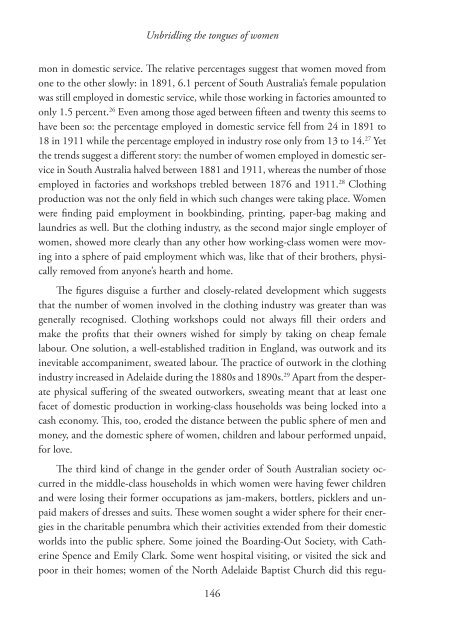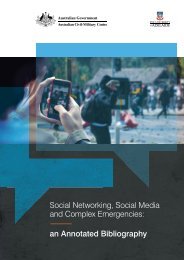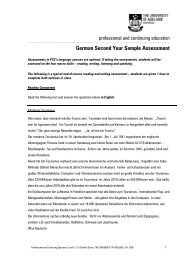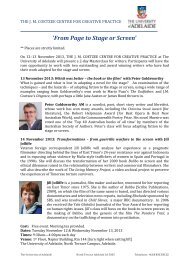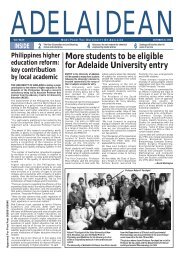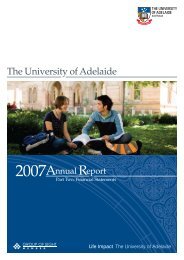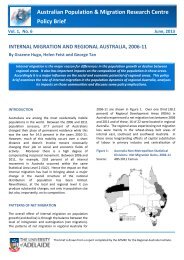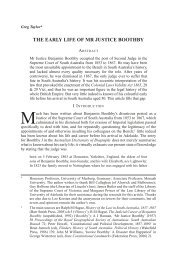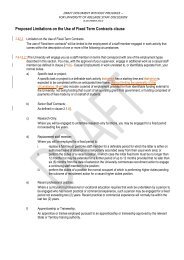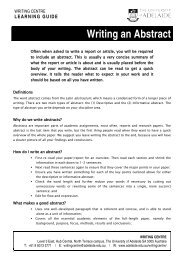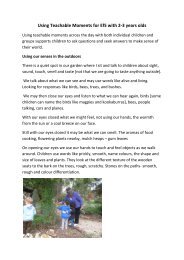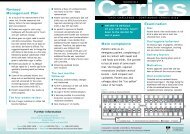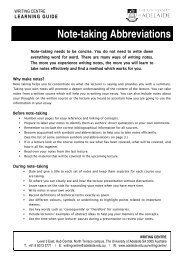Unbridling the Tongues of Women - The University of Adelaide
Unbridling the Tongues of Women - The University of Adelaide
Unbridling the Tongues of Women - The University of Adelaide
You also want an ePaper? Increase the reach of your titles
YUMPU automatically turns print PDFs into web optimized ePapers that Google loves.
<strong>Unbridling</strong> <strong>the</strong> tongues <strong>of</strong> women<br />
mon in domestic service. <strong>The</strong> relative percentages suggest that women moved from<br />
one to <strong>the</strong> o<strong>the</strong>r slowly: in 1891, 6.1 percent <strong>of</strong> South Australia’s female population<br />
was still employed in domestic service, while those working in factories amounted to<br />
only 1.5 percent. 26 Even among those aged between fifteen and twenty this seems to<br />
have been so: <strong>the</strong> percentage employed in domestic service fell from 24 in 1891 to<br />
18 in 1911 while <strong>the</strong> percentage employed in industry rose only from 13 to 14. 27 Yet<br />
<strong>the</strong> trends suggest a different story: <strong>the</strong> number <strong>of</strong> women employed in domestic service<br />
in South Australia halved between 1881 and 1911, whereas <strong>the</strong> number <strong>of</strong> those<br />
employed in factories and workshops trebled between 1876 and 1911. 28 Clothing<br />
production was not <strong>the</strong> only field in which such changes were taking place. <strong>Women</strong><br />
were finding paid employment in bookbinding, printing, paper-bag making and<br />
laundries as well. But <strong>the</strong> clothing industry, as <strong>the</strong> second major single employer <strong>of</strong><br />
women, showed more clearly than any o<strong>the</strong>r how working-class women were moving<br />
into a sphere <strong>of</strong> paid employment which was, like that <strong>of</strong> <strong>the</strong>ir bro<strong>the</strong>rs, physically<br />
removed from anyone’s hearth and home.<br />
<strong>The</strong> figures disguise a fur<strong>the</strong>r and closely-related development which suggests<br />
that <strong>the</strong> number <strong>of</strong> women involved in <strong>the</strong> clothing industry was greater than was<br />
generally recognised. Clothing workshops could not always fill <strong>the</strong>ir orders and<br />
make <strong>the</strong> pr<strong>of</strong>its that <strong>the</strong>ir owners wished for simply by taking on cheap female<br />
labour. One solution, a well-established tradition in England, was outwork and its<br />
inevitable accompaniment, sweated labour. <strong>The</strong> practice <strong>of</strong> outwork in <strong>the</strong> clothing<br />
industry increased in <strong>Adelaide</strong> during <strong>the</strong> 1880s and 1890s. 29 Apart from <strong>the</strong> desperate<br />
physical suffering <strong>of</strong> <strong>the</strong> sweated outworkers, sweating meant that at least one<br />
facet <strong>of</strong> domestic production in working-class households was being locked into a<br />
cash economy. This, too, eroded <strong>the</strong> distance between <strong>the</strong> public sphere <strong>of</strong> men and<br />
money, and <strong>the</strong> domestic sphere <strong>of</strong> women, children and labour performed unpaid,<br />
for love.<br />
<strong>The</strong> third kind <strong>of</strong> change in <strong>the</strong> gender order <strong>of</strong> South Australian society occurred<br />
in <strong>the</strong> middle-class households in which women were having fewer children<br />
and were losing <strong>the</strong>ir former occupations as jam-makers, bottlers, picklers and unpaid<br />
makers <strong>of</strong> dresses and suits. <strong>The</strong>se women sought a wider sphere for <strong>the</strong>ir energies<br />
in <strong>the</strong> charitable penumbra which <strong>the</strong>ir activities extended from <strong>the</strong>ir domestic<br />
worlds into <strong>the</strong> public sphere. Some joined <strong>the</strong> Boarding-Out Society, with Ca<strong>the</strong>rine<br />
Spence and Emily Clark. Some went hospital visiting, or visited <strong>the</strong> sick and<br />
poor in <strong>the</strong>ir homes; women <strong>of</strong> <strong>the</strong> North <strong>Adelaide</strong> Baptist Church did this regu-<br />
146


